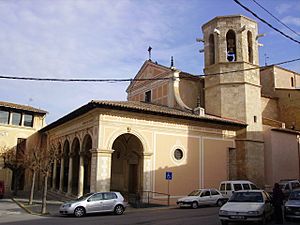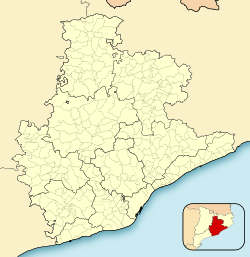Sant Sadurní d'Anoia facts for kids
Quick facts for kids
Sant Sadurní d'Anoia
|
||
|---|---|---|
|
Municipality
|
||

Church
|
||
|
||
| Country | ||
| Community | ||
| Province | Barcelona | |
| Comarca | Alt Penedès | |
| Area | ||
| • Total | 19.0 km2 (7.3 sq mi) | |
| Elevation | 162 m (531 ft) | |
| Population
(2018)
|
||
| • Total | 12,866 | |
| • Density | 677.2/km2 (1,754/sq mi) | |
| Demonym(s) | Sadurninenc | |
| Postal code |
08770
|
|
Sant Sadurní d'Anoia is a town in Catalonia, Spain. It is famous for making a special bubbly wine called cava. The town is located in the Alt Penedès region, where two rivers, the Avernó and Anoia, meet. You can easily reach it by highway or train from Barcelona.
The beautiful buildings of the Codorníu cava house were designed by a famous architect named Josep Puig i Cadafalch.
Contents
A Look Back in Time
Sant Sadurní started as a small church area called Sant Sadurní de Subirats around the year 1080. It was part of a larger area ruled by noble families. In 1493, it became part of the Crown of Aragon. For many years, it was just a few houses along the road between Tarragona and Barcelona. Its location helped it grow more than nearby villages.
In 1764, Sant Sadurní de Subirats became its own town. It changed its name to Sant Sadurní d'Anoia, taking part of its name from the Anoia River. The town's history changed a lot in the late 1800s. People here grew a lot of grapes for wine. In 1872, they started making the first bottles of cava.
A big problem hit in 1887: the phylloxera plague. This tiny insect destroyed many grapevines. But the people of Sant Sadurní fought back strongly. They became leaders in finding ways to stop the plague. After this, making cava became even more important. Sant Sadurní d'Anoia is now the biggest center for cava production.
Fun Festivals and Events
Sant Sadurní d'Anoia has many exciting festivals throughout the year.
Neighborhood Celebrations
The "Festes dels Barris" (Neighborhood Festivals) last for seven days. They start on the first Thursday after Corpus Christi. Each day, one of the town's seven old neighborhoods celebrates. These neighborhoods are Ajuntament, Sant Antoni, Montserrat, Església, Diputació, Cavallers, and Raval.
Every day at 2 PM, a loud thunderstorm sound is made. This shows that one neighborhood is passing the celebration to the next. In the evening, there is a fireworks show. The next day, a parade called the Rengle goes through the neighborhood streets. It ends at the main church. The Església neighborhood also decorates its street with a beautiful carpet of flowers.
Main Town Festivals
"Les Fires i Festes" (Fairs and Festivals) happen from September 6 to 9. They celebrate the grape harvest. The most special part is the "Phylloxera Festival" on the evening of September 8. It takes place in the Church Square. This festival remembers the history of the phylloxera plague. It shows the battle between farmers and the insect, and how the farmers finally won. These are the town's main celebrations.
In the past, these fairs were very important for farmers. They would buy horses, carts, barrels, and tools for making wine. Today, the fun and party parts have become more important than the shopping.
On September 6, before the opening, there is a traditional meeting for people who make lace. At 8 PM, the fairs officially open with a ceremony. There are also shows by the "hawks" (human towers) from the cava region. At night, there are street parties, concerts, and dancing until morning.
On September 7, you can find shows for children, and tennis and soccer games. In the afternoon, there are more children's shows and traditional sardana dances. At 10 AM and at midnight, fireworks light up the sky at Parc del Gat Cendrer. After the midnight fireworks, the "spread of phylloxera" begins. This is a play where two groups of "phylloxis" (people dressed as phylloxera insects) run through the streets. They meet in Era d'en Guineu square. This square is in front of Can Guineu, a building owned by Marc Mir i Capella, one of the "Seven Wise Men of Greece" who fought the phylloxera plague. A "great phylloxera" also joins the show.
Cava Week
"La setmana del cava" (Cava Week) is held in the second week of October. During this week, the cava brotherhood crowns new "ambassadors of the cava." The town hall also organizes the "Cavatast" fair. Here, the best cava makers gather to let people taste their finest cavas.
Patron Saint Day
The "Festa Major" is on November 29. This day celebrates the town's patron saint, Sant Sadurní.
Nearby Villages
Sant Sadurní d'Anoia includes four smaller villages:
- Can Benet de la Prua (94 people in 2005)
- Can Catassús (124 people in 2005)
- Espiells (54 people in 2005), which has an old church called Sant Benet.
- Monistrol d'Anoia (28 people in 2005)
Sports in Sant Sadurní
The town was a host for the 1992 Summer Olympics. The individual road race cycling event took place here.
Roller Hockey
Sant Sadurní d'Anoia has a very important roller hockey team called Club Esportiu Noia. They play in Spain's top league, the OK Liga.
Sister Cities
 Cañete la Real, Spain
Cañete la Real, Spain
Famous People from Sant Sadurní
- Pau Bargalló Poch: A roller hockey player who is a current world champion.
- Jordi Bargalló Poch: Another roller hockey player, a world champion many times (2007, 2009, 2011, 2013).
- Pedro Gil Gómez: A well-known roller hockey player.
- María Asunción Raventós: An artist.
- Miquel Reina: An author and designer.
- Àlex Moreno: A footballer who plays for Aston Villa.
- Javier del Amor: A former Spanish motorcycle racer.
See also
 In Spanish: San Sadurní de Noya para niños
In Spanish: San Sadurní de Noya para niños




